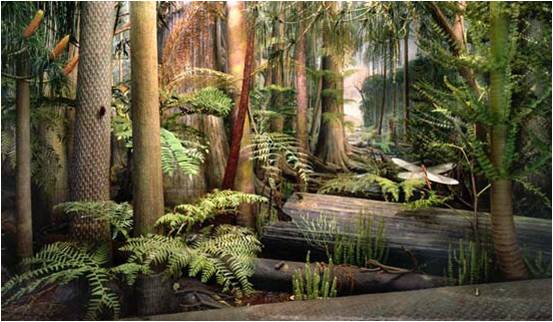 I.
A Brief History of Life
I.
A Brief History of Life I.
A Brief History of Life
I.
A Brief History of Life1. Green Algal Ancestors
2. Colonization of Land: Environmental Differences
3. Plant Evolution: Adapting to Land
4. Primitive Plants - the "non-tracheophytes"
5. Tracheophytes
a. Characteristics
b. Groups:
i. Lycopodiophyta:
ii. Monilophytes: These are the ferns and their allies; they form a a monophyletic group of euphyllophyte plants (with true leaves) that, like all plants we have considered, do not produce seeds and have swimming sperm. The other euphyllophytes DO produce seeds, and form the monophyletic group called the Spermatophytes. Some of the Monilophytes, like Equisetum and Psilotum, don't look much like a fern... however, their life cycles, presence of sporangia, and genes show their relationship to the ferns.
Diversity:
The Ophioglassales and Psilotales are very unusual ferns - they have a highly reduced morphology such that Ophioglossum has but a single, 2-part frond and Psilotum lack any fronds (leaves) at all. Psilotum was thought to be related more closely to Lycopods until genetic analyses revealed a closer association with ferns.
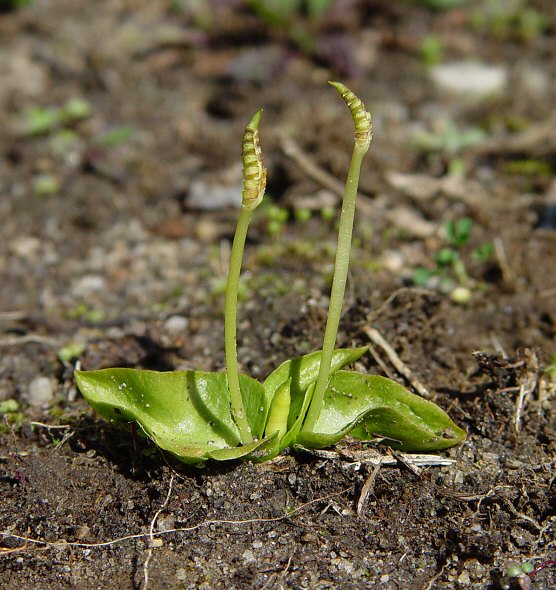 |
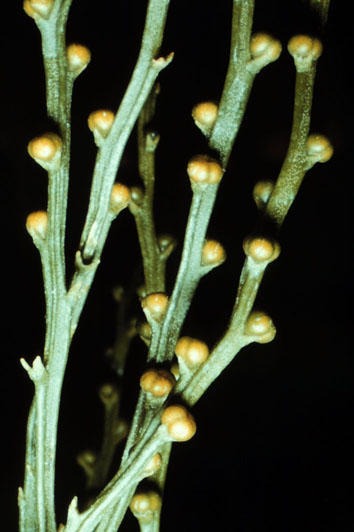 |
| Ophioglossum | Psilotum |
The Equisetales are another group of fern relatives, known as "horsetails" . They also have a reduced morphology that made their taxonomic placement difficult before genetic analyses reveal their close relationship to ferns. The leaves of horsetails are very reduced, like in Psilotales - in fact, the leaves are the small, brown, triangular structures that stick up at each 'node' along the stem. The leaves do not photosynthesize; that function is performed by the stem. There are branching types of horsetails, too, with lateral branches arising as whorls from each node of the stem. Horsetails are sometimes called "scouring rushes"; they are very tough and often have accumulated silica in their tissues. They were used by native Americans and early colonists and settlers to scrub pots clean. Giant horsetails in South America can grown 12 ft tall.
Another odd group are the Salvinales. These are water ferns, and they are actually the sister group to the true ferns. They have diverged morphologically to adapt to aquatic habitats.
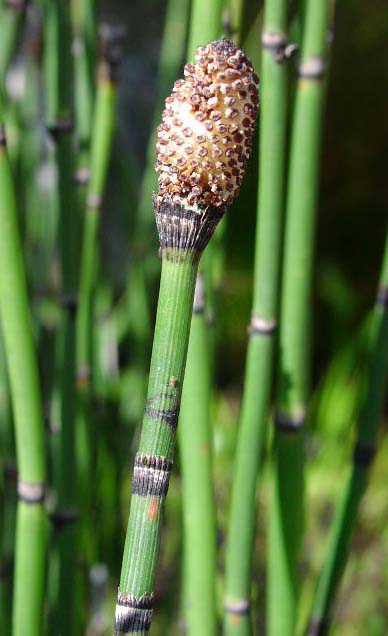 |
 |
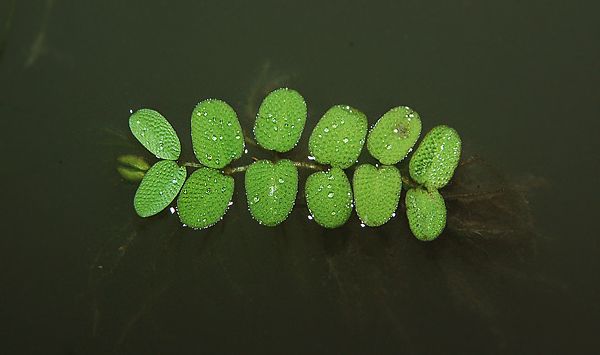 |
| Brown leaves | branches in whorls | Salvinia - a fern relative adapted to aquatic habitats |
The more 'typical' ferns fall into three groups. The Osmundales have dimorphic fronds - one type is broad and green and photosynthetic, the other bears the spores. The cinnamon fern is a classic representative of this group, and it's tall spikes of spore-bearing leaves are easy to recognize. The other two clades of ferns are the most species-rich groups. The Cyatheales include the "tree ferns" that can grow over 20 feet tall. Their rhizome grows vertically as a trunk-like structure, and then a whorl of long fronds radiate. Most tree ferns have tropical distributions, but some prefer the cooler habitats of cloud forests at high elevations, and some reach temperate latitudes - such as the Tasmania tree fern. The vast majority of Monilophytes are in the Polypodiales - this group includes about 1200 of the 1500 species of Monilophytes, and includes the typical ferns that you know, like bracken fern and staghorn fern.
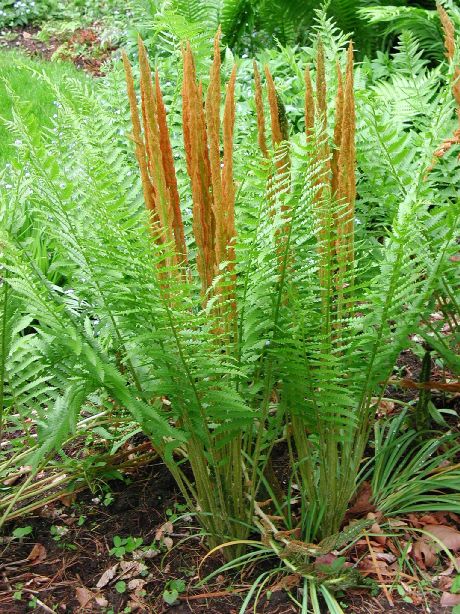 |
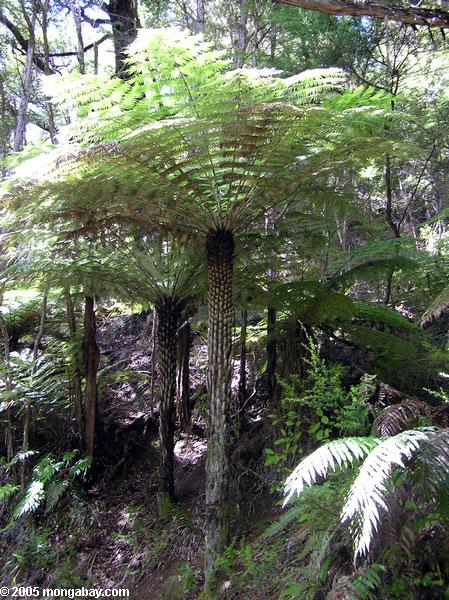 |
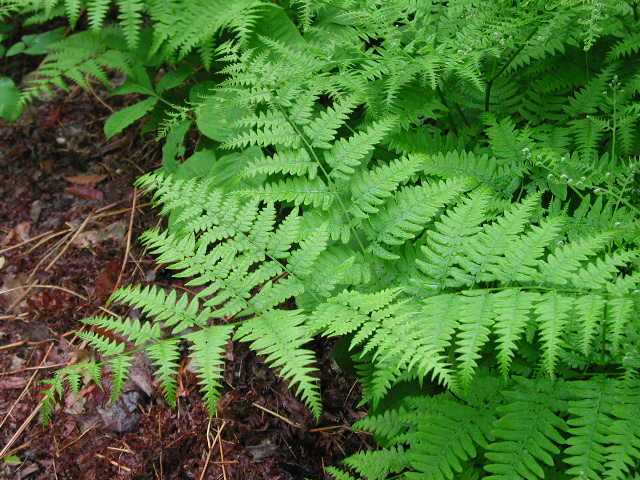 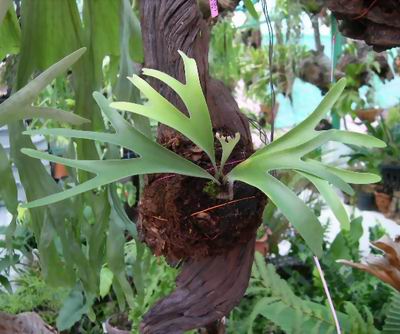 |
| Osmunda | Tree fern | Bracken fern and staghorn fern - Polypodiales |
 The
fern life cycle is very similar to the clubmosses; indeed, these groups were
sometimes grouped together. Ferns have a dominant sporophyte that produces true
leaves (fronds). In many species, the leaves bear sporangia underneath, which
produce spores by meiosis. The haploid spores are released, and they develope
into small, independent gametophytes that live in the leaf litter. The gametophytes
bear antheridia and archegonia, that produce sperm and egg, respectively, by
mitosis. The flagellated sperm swim to the egg, and the diploid zygote divides
and grows in the archegonium and becomes the large sporophyte.
The
fern life cycle is very similar to the clubmosses; indeed, these groups were
sometimes grouped together. Ferns have a dominant sporophyte that produces true
leaves (fronds). In many species, the leaves bear sporangia underneath, which
produce spores by meiosis. The haploid spores are released, and they develope
into small, independent gametophytes that live in the leaf litter. The gametophytes
bear antheridia and archegonia, that produce sperm and egg, respectively, by
mitosis. The flagellated sperm swim to the egg, and the diploid zygote divides
and grows in the archegonium and becomes the large sporophyte.
The great swamp forests of the Carboniferous (360-286 mya, sometimes split into Mississippian and Pennsylvanian, as in the ppt) were dominated by lycopods like Lepidodendron. Tree ferns were common in the understory, and smaller lycopods and ferns were common in the herb layer, as they are today. As the large plants in these forest died, they fell into the shallow swamps and were covered by sediments. Instead of being decomposed, the organic remains were fossilized, becoming our major coal deposits and giving the period its name (Carboniferous). This huge transfer of carbon to the lithosphere changed the atmospheric balance of carbon dioxide and oxygen. The photosynthetic plants were producing lots of oxygen and were absorbing lots of carbon dioxide, coverting carbon dioxide to glucose and cellulose. Typically, the action of aerobic, decomposers would consume some of this oxygen during their respiration, and would break down the cellulose and glucose into carbon dioxide. Thus, the effects of photosynthetic organisms on the atmosphere is balanced by the effects of decomposers. However, the sequestering of this plant biomass beneath sediment meant that it wasn't metabolized and recycled; it was protected from decomposers. So, oxygen concentrations continued to rise and carbon dioxide levels dropped. Some biologists believe that the high oxygen levels may have been a factor that allowed for the largest terrestrial arthropods to survive - including a dragonfly with a 2 ft wingspan and a millipede 6 feet long. Because arthropods respire by simple diffusion, large arthropods could only receive enough oxygen to maintain their metabolic demands if the concentration gradient was so large that oxygen poured deep into tissues.
In the Permian Period, the continents united into the supercontinent of Pangaea. This land mass had a lower ratio of coastine to land area than multiple independent continents, and so most of the land mass of Pangaea was far from coastal areas. As a consequence, the terrestrial environment went through a drying period; a period which favored new groups of organisms that had evolved characteristics that would give them a selective advantage in dry environments. These organisms were the gymnosperms and the reptiles, and their adaptations were seeds and desiccation-resistant shelled eggs, respectively.
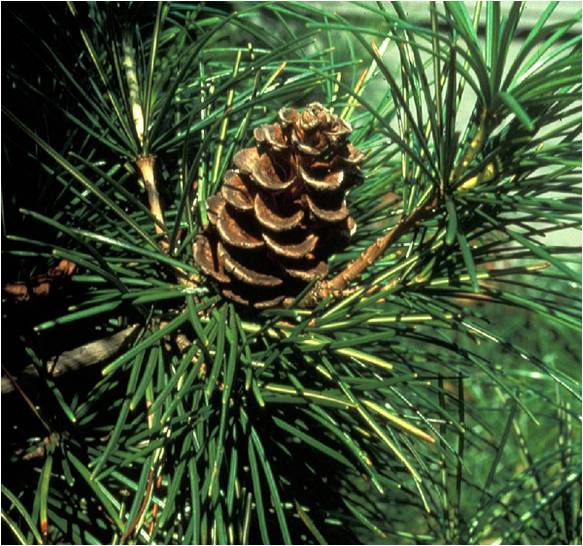 iii.
Gymnosperms: The
gymnosperms evolved during the Carboniferous but came to dominate terrestrial
landscapes during the Permian Period, when the unification of Pangaea created
a drier terrestrial climate. They would continue to dominate through the first
part of the Mesozoic. Modern gymnosperms include the conifers (pines, fir, spruce,
hemlock, yew, redwoods,cedars, cypress, larch, etc.), the cycads, and the Ginkgo
(one relict species). Another group, the Gnetales, contains some very unusual
gymnosperms that have some characteristics of angiosperms. The gymnosperms probably
evolved from an earlier group of plants called the "Seed ferns". Seeds
ferns were the first plants to produce seeds and pollen; characteristics which
would allow their descendants to dominate terrestrial habitats. The seed ferns
are an extinct group, so we will use the modern Gymnosperms to describe the
importance of these key evolutionary innovations.
iii.
Gymnosperms: The
gymnosperms evolved during the Carboniferous but came to dominate terrestrial
landscapes during the Permian Period, when the unification of Pangaea created
a drier terrestrial climate. They would continue to dominate through the first
part of the Mesozoic. Modern gymnosperms include the conifers (pines, fir, spruce,
hemlock, yew, redwoods,cedars, cypress, larch, etc.), the cycads, and the Ginkgo
(one relict species). Another group, the Gnetales, contains some very unusual
gymnosperms that have some characteristics of angiosperms. The gymnosperms probably
evolved from an earlier group of plants called the "Seed ferns". Seeds
ferns were the first plants to produce seeds and pollen; characteristics which
would allow their descendants to dominate terrestrial habitats. The seed ferns
are an extinct group, so we will use the modern Gymnosperms to describe the
importance of these key evolutionary innovations.
- Characteristics
The seed: The plants that we have examined so far produce the diploid zygote on the female gametophyte - in the vase-like archegonium. As such, the dispersal phase of the life cycle is the spore. Spores are single celled, and although they may be dessication resistant, once they germinate and begin to grow, they must be able to immediately meet their biological needs with material they absorb from the environment. In the "seed plants" (seed ferns, gymnosperms, and angiosperms), the female gametophyte is retained on the sporophyte plant, and becomes the dispersal vessel for its offspring, the next generation of embryonic sporophyte. Here's what happens: The sporophyte produces two types of spores, large and small. Inside the ovule, a 2n cell (megasporocyte) divides by meiosis. The cytoplasm is divided unequally, producing three reduced non-functional cells and one large functional spore - the megaspore. This megaspore, nested within the ovule, divides mitotically and developes into the female gametophyte. The female gametophyte produces the egg, located at one end of the female gametophyte, within the ovule. Fertilization of the egg by sperm forms the diploid zygote. This divides to become the diploid embryo, all still surrounded by haploid gametophyte tissue, within original 2n ovule tissue. This is the seed: 2n ovule tissue (seed coat), surrounding 1n female gametophyte tissue, surrounding the 2n embryo. The gametophyte tissue stores energy in the form of fats and lipids. When the seed is dispersed, the developing embryo now has a source of nutrients to use to produce its initial roots and leaves and become established in the environment. The seed represents a way that the plant can invest MORE ENERGY in each offspring, increasing the probability of survival.
Pollen: Correlated with the production of seeds is the production of pollen. As mentioned above, the sporophyte produces two types of spores, large and small. Each small spore divides and becomes a multicellular haploid male gametophyte - a pollen grain. These pollen grains are released from the sporophyte plant, and are carried by air currents to female cones which house the female gametophyte. The pollen grain then produces sperm. Cycads and ginkgo produce flagellated sperm, but conifers and gnetales produce non-motil sperm. In either case, the sperm is already at the egg. Obviously, the evolution of pollen, that carries sperm through the environment, meant that water was no longer required as a vehicle for reproduction. Plants were now free to colonize uplant areas away from water.
- Diversity:
There are four groups of living gymnosperms. The cycads are the most primitive group, perhaps reminiscent of the seed ferns from which the gymnosperms evolved. They still have flagellated sperm (an ancestral trait), and stiff, tough, frond-like leaves. Some Cycads even bear megaspores on leaves like the ferns do, although the male microspores and pollen are produced in cones. They also have an unbranched stem that is similar to tree ferns. They do produce true seeds, however, and thus are true (though primitive) gymnosperms. The Ginkgo tree is an unusual species - it is the only species in its entire Order (Ginkgoales) - the last species remaining from a previously diverse group. It also has the primitive trait of flagellated sperm. Pollen is produced in cones, but megaspores are produced in fruit-like structures. The third group - Gnetales, - is the sister group to conifers and is a diverse collection of odd plants. The most diverse group of gymnosperms on the planet today is the conifers. This group includes ~600 of the roughly 900 species of gymnosperms (compared to 300,000 species of flowering plants!!). The group includes the largest plants on earth - the tall redwoods and the massive sequioas. It also includes the oldest plants on the planet - some redwoods and bristlecone pines are over 5000 years old. Conifers include pines, fir trees, spruce, larch, yews, cypress, redwoods and sequioas, hemlock, cedar, and juniper. Conifers, like other gymnosperm groups, arose in the Carboniferous and radiated in the Permian when the climate became drier. Conifers, in particular, radiated during the Mesozoic, filling plant niches emptied by the great Permian extinction. Conifers continue to dominate dry environments, today. They dominate dry coastal habitats where sandy soils reduce water availability, they dominate dry mountain slopes, and they dominate cold habitats at high elevations and high latitudes where water is often frozen and unavailable. Indeed, the boreal forest - one of the largest terrestrial biomes on the planet, is overwhelmingly dominated by conifers. So, although their diversity has diminished and although they have been numerically dominated by flowering plants, gymnosperms continue to be very important components of many terrestrial habitats.
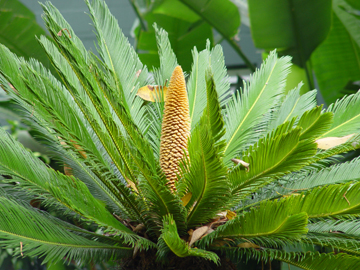 |
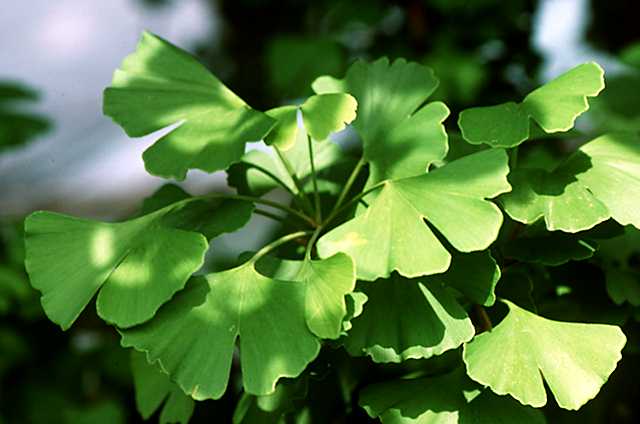 |
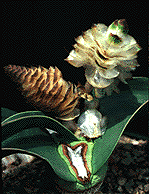 |
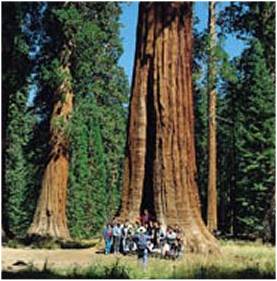 |
| Cycads have large, fern-like leaves | Ginkgo is a single 'living fossil' species | Gnetales are just weird | Conifers still dominate many habitats |
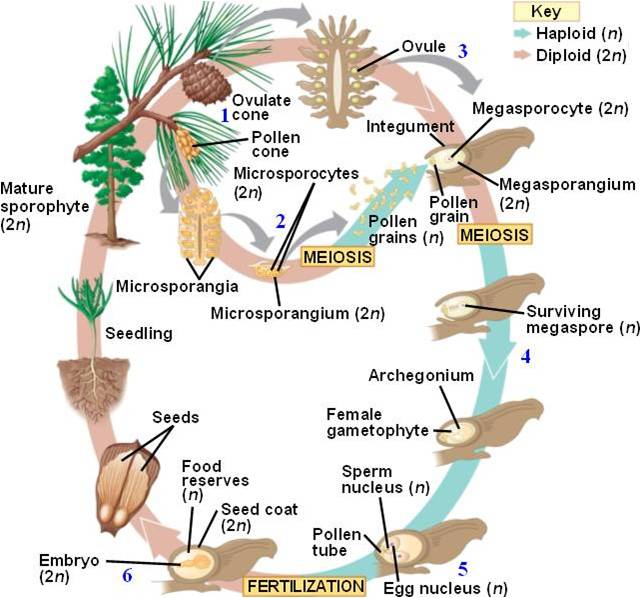 Life
cycle: We will use a pine tree (conifer) as our example of the gymnosperm
life cycle. Consider a mature pine tree - it is the diploid sporophyte generation.
It produces two types of cones, male and female. In the male cones, in compartments
on each "scale", 2n microsporocyte cells go through meiosis and produce
4 equally sized haploid microspores. Each microspore divides by mitosis and
develops into a mature haploid male gametophyte - a pollen grain. Each pollen
grain then produces haploid non-motil sperm by mitosis. Pine trees also have
larger, woody, female cones. In ovules on each scale of these cones, meiosis
occurs and produces a single large haploid spore - the megaspore. The megaspore
divides by mitosis, producing the multicellular haploid female gametophyte.
This megagametophyte produces the egg. There is a pore at one end of the ovule
called the micropyle. When the gametophyte is sexually mature, it secretes a
drop of fluid called the "pollen droplet". Pollen is released from
the male cones and wafts into the female cones. It gets stuck in the fluid droplet,
and as the droplet dries the pollen grain is pulled into the ovule. Inside the
ovule, a tube cell bores through the pollen grain, followed by sperm cells.
Fertilization takes place, forming a diploid zygote within the haploid female
gametophyte tissue. So, there is a diploid embryo, surrounded by haploid gametophyte
tissue, surrounded by a thin covering (seed coat) of grand-parental sporophyte
tissue. This three-layered structure is the seed, and it can be dispersed to
a new environment and gain a footing in that habitat by using the energy packet
along in the female gametophyte tissue.
Life
cycle: We will use a pine tree (conifer) as our example of the gymnosperm
life cycle. Consider a mature pine tree - it is the diploid sporophyte generation.
It produces two types of cones, male and female. In the male cones, in compartments
on each "scale", 2n microsporocyte cells go through meiosis and produce
4 equally sized haploid microspores. Each microspore divides by mitosis and
develops into a mature haploid male gametophyte - a pollen grain. Each pollen
grain then produces haploid non-motil sperm by mitosis. Pine trees also have
larger, woody, female cones. In ovules on each scale of these cones, meiosis
occurs and produces a single large haploid spore - the megaspore. The megaspore
divides by mitosis, producing the multicellular haploid female gametophyte.
This megagametophyte produces the egg. There is a pore at one end of the ovule
called the micropyle. When the gametophyte is sexually mature, it secretes a
drop of fluid called the "pollen droplet". Pollen is released from
the male cones and wafts into the female cones. It gets stuck in the fluid droplet,
and as the droplet dries the pollen grain is pulled into the ovule. Inside the
ovule, a tube cell bores through the pollen grain, followed by sperm cells.
Fertilization takes place, forming a diploid zygote within the haploid female
gametophyte tissue. So, there is a diploid embryo, surrounded by haploid gametophyte
tissue, surrounded by a thin covering (seed coat) of grand-parental sporophyte
tissue. This three-layered structure is the seed, and it can be dispersed to
a new environment and gain a footing in that habitat by using the energy packet
along in the female gametophyte tissue.
With seed fern and conifer evolution, plants had finally become independent of an aquatic environment. No life stage needed liquid water as an environment, and these plant species could colonize the drier areas that were increasingly abundant as the Permian and Mesozoic progressed.
Study Questions:
1. Ferns and lycopods (clubmosses) dominated during the Carboniferous. Explain how their presence, and their fossilization, changed the atmospheric balance of CO2 and oxygen.
2. Draw the life cycle of a fern.
3. The two major innovations represented in the gymnosperms are seeds and pollen. Explain what each of these structures IS (in the contex of a plant life cycle), and explain how each structure allowed plants to colonize dry habitats.
4. What characteristics do cycads have that suggest they are a primitive group within the gymnosperms?
5. List three groups of monilophytes.
6. List three groups of gymnosperms.
7. Draw the life cycle of a conifer.